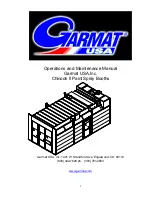
16-6 Acoustic Output
of Thermal or Mechanical effect. More specifically, they were designed to assist in the
implementation of the ALARA principle. As an operator changes a given system control,
the potential effect of the change in output will be indicated. However, the Thermal Index
is not the same as temperature rise in the body, for several reasons. First of all, in order to
provide a single display index to you, a number of simplifying assumptions had to be
made. The biggest assumption was the use of the attenuating formula described above,
which is much lower than the actual value for most tissues within the body. Scanning
through muscle or organ tissue, for example, will produce much higher attenuation than
0.3 dB/cm/MHz. There were also significant simplifications made for the thermal
properties of tissue. Therefore, scanning through highly perfused tissue, such as the heart
or vasculature, will produce significantly less thermal effect than that suggested by the
Thermal Index.
Similarly, the Mechanical Index was derived to indicate the relative possibility of
mechanical (cavitation) effects. The MI is based on the derated peak-rarefactional
pressure and the center frequency of the ultrasound wave. The actual peak-rarefactional
pressure is affected by the actual attenuation caused by tissue in the path between the
transducer and the focal point. Again, all solid tissues within the body have higher
attenuation than the proscribed 0.3 dB/cm/MHz value, and therefore, the actual
peak-rarefactional pressure will be lower. Further, the actual peak-rarefactional pressure
will change depending upon the region of the body being scanned.
For these reasons, the TI and MI displays should only be used to assist the operator in
implementing ALARA at the time of the patient examination.
16.8 Measurement Uncertainty
Ispta
28.5 %
Isppa
28.5 %
Center frequency (fc)
2%
Total power (W)
28.5 %
(5.1% for Scan-mode and Combined-mode)
Peak-rarefactional pressure
14.7 %
16.9 References for Acoustic Power and
Safety
1. “Bioeffects and Safety of Diagnostic Ultrasound” issued by AIUM in 1993
2. “Medical Ultrasound Safety” issued by AIUM in 1994
3. "Acoustic Output Measurement Standard for Diagnostic Ultrasound Equipment,
Revision 3" issued by AIUM/NEMA in 2004
4. "Standard for real-time display of thermal and mechanical acoustic output indices on
diagnostic ultrasound equipment, Revision 2" issued by AIUM/NEMA in 2004
5. "Information for Manufacturers Seeking Marketing Clearance of Diagnostic
Ultrasound Systems and Transducers" issued by FDA in 2008.
6. “Medical electrical equipment – Part 2-37: Particular requirements for the safety of
ultrasonic medical diagnostic and monitoring equipment” issued by IEC in 2005.
Summary of Contents for M5 Exp
Page 2: ......
Page 12: ......
Page 41: ...System Overview 2 11 UMT 200 UMT 300...
Page 246: ...12 2 Probes and Biopsy V10 4B s CW5s 4CD4s P12 4s 7L4s L12 4s P7 3s L14 6Ns P4 2s CW2s...
Page 286: ......
Page 288: ......
Page 336: ......
Page 338: ......
Page 357: ...P N 046 008768 00 V1 0...
















































